What’s inside this article: A look at the benefits of swinging for autistic children, different types of sensory swings, and the benefits of having a sensory swing in your home or classroom for kids with autism.
Disclaimer: This post contains affiliate links.
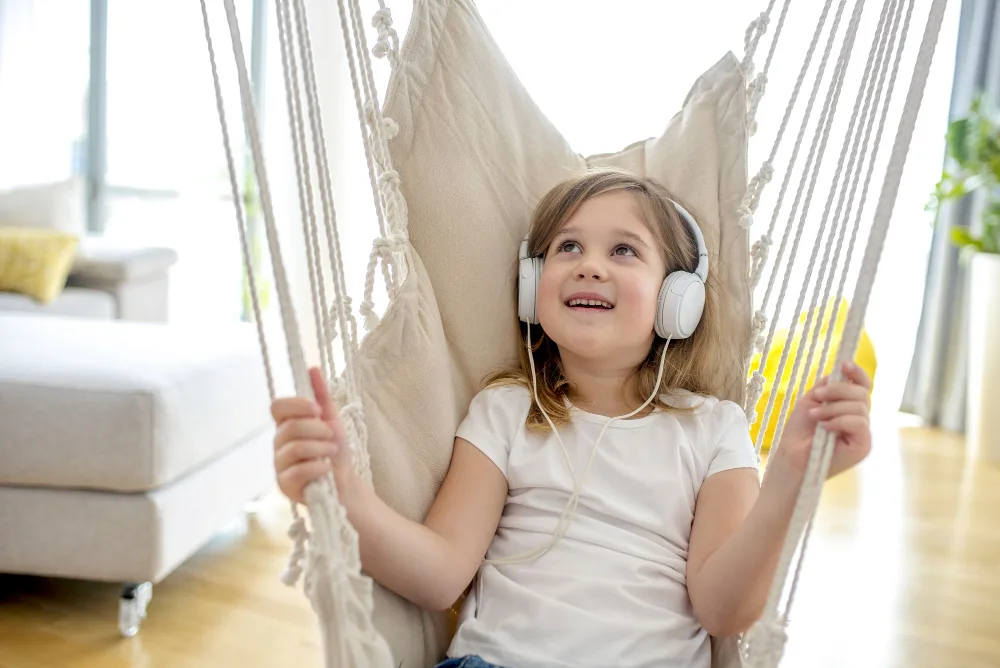
Autism spectrum disorder (ASD) is a complex neurodevelopmental disorder that affects how people see the world and interact with others. One key aspect of autism is sensory processing differences.
While the types of sensory processing differences vary significantly from person to person, one thing is certain: sensory integration activities have many benefits for autistic children.
As many as 20% of children have sensory processing issues. That number increases to 97% for children with autism.
This is where the therapeutic activity of swinging comes into play. Swinging offers a myriad of benefits, particularly for those with autism.
Benefits of Swinging for Autism
1. Regulation of the Vestibular System
The vestibular system, nestled within the inner ear, operates as the body’s “gyroscope.” It continuously sends data to the brain about the movement of the head, allowing us to understand our position in space, maintain balance, and regulate motor functions.
You can learn more about how this sensory system works here.
Swinging and the Vestibular System:
When a child with autism engages in swinging, there’s more happening than just the joy of motion. The back-and-forth or side-to-side motion of the swing offers consistent stimulation to the vestibular system.
This regular input helps enhance the system’s functioning, refining the brain’s interpretation of balance and spatial orientation.
Impact on Autism:
Children with autism sometimes face challenges with motor coordination and spatial awareness.
They may:
- Be clumsy, bumping into things or tripping frequently
- Struggle with new athletic activities and sports, like riding a bike, kicking and throwing, climbing, etc.
- Need extra time to plan motor movements
- Have poor performance in gym class
- Need additional time learning even simple motor movements. For example, waving or pointing
- Be late meeting developmental milestones related to movement, such as crawling, walking, standing, etc.
The improved regulation of the vestibular system through swinging can help in reducing these challenges.
Over time, as the system is repeatedly and consistently stimulated, children can exhibit reduced clumsiness and improved motor coordination.
2. Calming and Soothing Effect
Repetitive and rhythmic motions like swinging have a deeply soothing effect on most individuals, not just those with autism.
This is because the brain starts anticipating the motion, creating a predictable pattern that is calming for our nervous system.
Swinging’s Impact:
Due to sensory sensitivities, the world can sometimes seem overwhelming for children with autism. The rhythmic motion of swinging acts as predictable and controlled sensory input amidst the chaos.
This consistency can significantly reduce episodes of anxiety, meltdowns, or other disruptive behaviors, serving as a sensory “reset.”
3. Improved Focus and Attention
When the brain receives organized and structured sensory input, like the motion from swinging, it can better process other stimuli in the environment.
This structured input essentially helps “tune” the brain. And this improved focus doesn’t stop when they stop swinging; it can last for hours.
Post-Swinging Benefits:
After a swinging session, the organized state of the brain can persist for a while.
Many caregivers, teachers, and therapists observe that children with autism can focus better, process information more efficiently, and engage in tasks for longer durations after swinging.
Essentially, the act of swinging helps declutter the mind.
4. Muscle Development and Tone
Swinging is a gross motor activity, and while it might look effortless, swinging requires the engagement of multiple muscle groups. From gripping the chains or ropes to stabilizing the body during motion, various muscles are at work.
Swinging’s Role in Physical Development:
Regular swinging can enhance muscle tone and strength, especially in the core, legs, and arms. This physical engagement can be invaluable for children with autism, especially those with hypotonia (reduced muscle tone).
Over time, consistent swinging can contribute to better posture, improved physical coordination, and overall physical development.
5. Enhanced Social Skills
While swinging can be enjoyed solo, playgrounds and therapy sessions often position it as a group activity.
This shared experience becomes an avenue for social development.
The Social Dimensions of Swinging:
Swinging can introduce autistic children to various social concepts like taking turns, sharing, and understanding personal space.
Even the simple act of pushing someone on a swing or engaging in parallel play on adjacent swings can foster communication, patience, and the understanding of social cues.
Over time, these interactions can enhance their social skills and confidence in group settings.
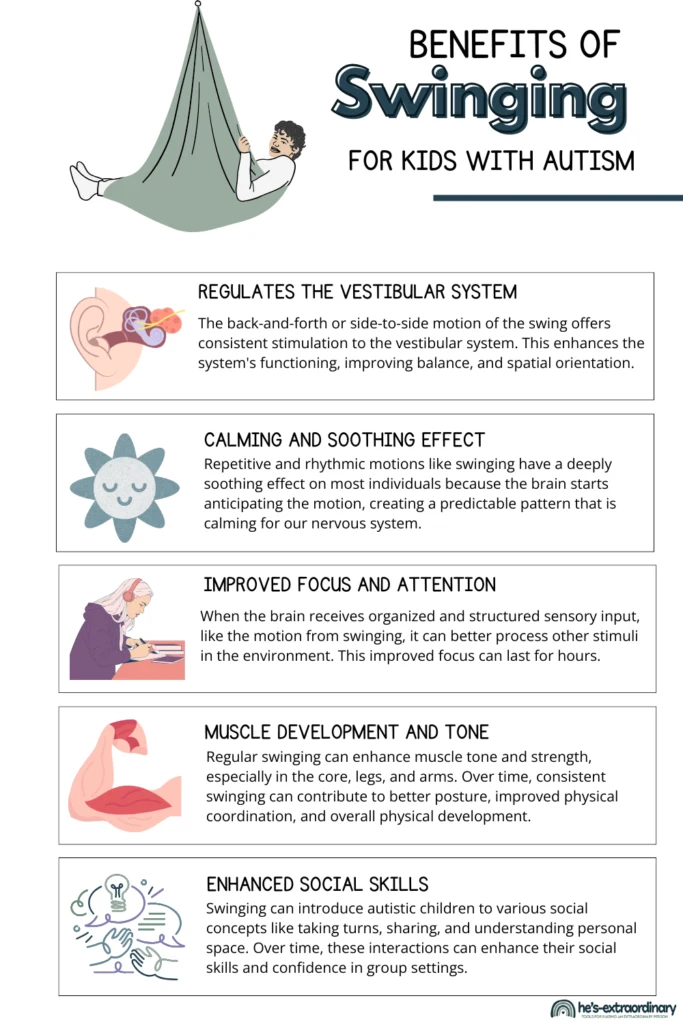
Sensory Swings: A Closer Look
As the name suggests, sensory swings are designed specifically to offer sensory input. They are often used in sensory integration therapy, a therapeutic approach that helps individuals with sensory processing challenges.
For those with autism, sensory swings can be a game-changer.
How Are Sensory Swings Used?
Sensory swings provide controlled sensory input, which can either be soothing or stimulating, depending on the individual’s needs.
Therapists and caregivers can use these swings to help children self-regulate, calm down, or become more alert. The swing’s movement can be adjusted—fast or slow, high or low—to achieve the desired sensory experience.
Different Types of Sensory Swings:
Pod or Cocoon Swings:
These swings envelop the individual, offering a cocoon-like feeling. This gives a sense of security and can be particularly calming for those who feel overwhelmed by their surroundings.
The Hearthsong HuddlePod (pictured below) is designed to block out external feedback and create a desensitizing environment. This is beneficial for children experiencing sensory overload.
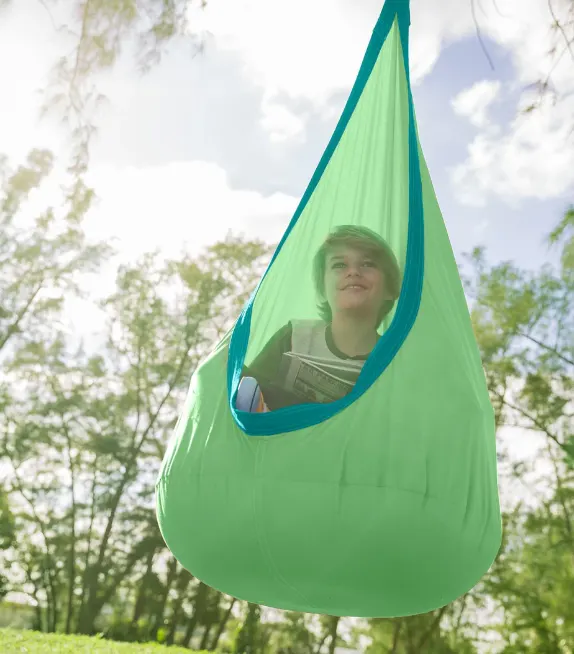
Platform Swings:
These are flat and allow the user to sit, stand, or lie down. They are excellent for balance and coordination exercises.
They also allow kids who need physical support to lie comfortably without concern of rolling off to still enjoy the benefits of swinging.

Hammock Swings:
Made of stretchy material, these swings cradle the individual, offering gentle pressure all over the body, similar to a deep-pressure hug. This has the added benefit of providing proprioceptive input.
The SensoryRx Hammock Swing (pictured below) can support up to 500 lbs. Kids can jump on it like a trampoline, hang in it like a cocoon and swing, lie in it and enjoy the deep pressure, or crawl inside the fabric layers.
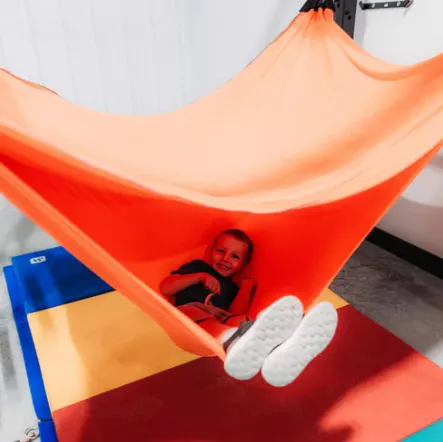
Rotational Swings:
These swings can spin, offering added vestibular input. They are great for sensory seekers who crave intense motion-based stimulation. Some examples include the SensoryRX Ninja Spin Wheel and the SwRing™ (pictured below – available soon).
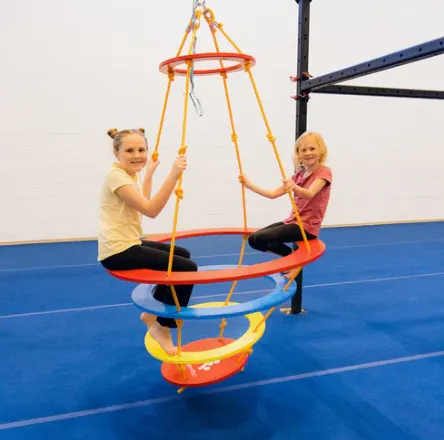
Benefits of Using Sensory Swings in Your Home or Classroom:
Considering the multitude of benefits they offer, sensory swings can be a valuable addition to homes and classrooms.
Here’s why:
- Accessible Therapy: Having a swing at home means children can access its benefits anytime, making it easier for them to self-regulate and cope with daily stresses.
- Encourages Play and Activity: In today’s digital age, getting children to be physically active can be challenging. Swings provide a fun way to be active, promoting physical health and well-being.
- Builds Independence: As children learn to use the swing, they can also learn about their own sensory needs and how to meet them independently.
- Facilitates Learning: In classrooms, a short break on a sensory swing can help children refocus, making learning more effective. Fulfilling sensory needs helps the brain stay engaged and attentive.
- Improves Social Interactions: Sensorily balanced children feel less anxious, which makes them more likely to engage in positive social interactions.
Swinging, particularly on sensory swings, offers immense therapeutic benefits for autistic kids.
Whether at home, in the classroom, in a sensory room, or on the playground, swinging can be a simple yet effective tool for helping those on the spectrum navigate their sensory world with more ease and confidence.
